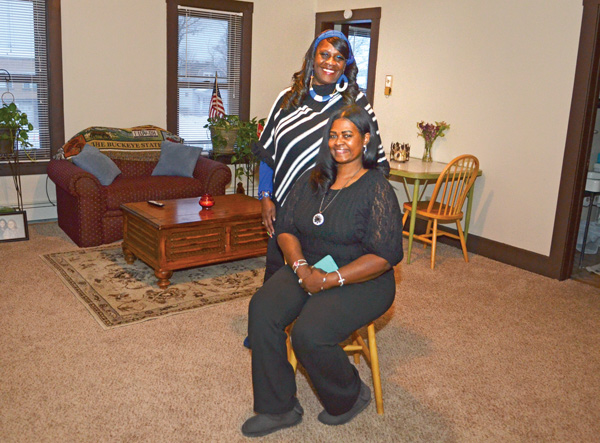Transitional housing helps homeless women recover


Vickie Winphrie, a case manager at the YWCA in Youngstown, stands behind Charmet Mitchell, a residential aide. The two are in an apartment that’s made available to women in need through the Y’s transitional-housing program.
YOUNGSTOWN
A 26-year-old single mother, along with her 2-year-old daughter, came from out of town to help her father and found herself homeless.
“I was scared,” said another single woman, 18, who had no place to go after five months in rehabilitation.
Another woman, 47, recently had hand surgery and can’t work. She was going to be evicted on a Friday but on Wednesday got a shared apartment at the Youngstown YWCA’s Barbara Wick Transitional House.
“I really love it here. The apartment is completely furnished and very nice. It is a way for people to get a fresh start,” the older woman said.
“The hardest part is having a child to take care of. This program helped me get on my feet,” said the single mom. “You don’t have to be scared. The world is crazy enough. I was going to sleep in a car.”
The transitional-housing program is designed to help homeless women get back on their feet, said Vicki Winphrie, a transitional- program case manager.
In addition to a case manager, the program has a monitor to ensure house rules are adhered to and to provide assistance in case of an emergency.
“We accept women who are homeless and give them job-hunting skills and coping skills, stabilize mental- health issues, and to think rationally and clearly,” said Winphrie.
Here, they can get out of the elements and take a shower and work on their resources and set goals, she said.
For example, the single mom, who has been in transitional housing for a month, had three main goals: Find a place for her and her daughter to live; start college; and find a job.
“I’ve accomplished all three,” she said.
The 18-year-old plans to get a job and a driver’s license and start beauty school in the near future.
The 47-year-old is applying for Supplemental Security Income disability.
People can stay in transitional housing for up to a year, said Leah Brooks, executive director of the Youngstown YWCA.
“In theory, they graduate to scattered site housing,” said Brooks, of Sharpsville, Pa., who started at the Y in 1994 as a part-time employee, became assistant health promotions manager, and was named director July 1, 2012.
The Youngstown YWCA’s Housing with Supportive Services program, which is for Youngstown and Mahoning County residents, served more than 230 individuals in 2014 through its Permanent, Scattered Site and Transitional housing programs. The Youngstown YWCA provides supportive housing for homeless low-income single women when they need a place to stay and a strong support system when they begin rebuilding their lives, Brooks said.
The Y’s sites are: YWCA Rayen Apartments, subsidized permanent housing for income-eligible women in the YW building in Youngstown’s downtown area; Scattered Site housing in which families live in independently owned rental units and are required to pay a percentage of their rental cost; and the Barbara Wick Transitional House program, which focuses on women age 18 to 24.
Brooks said 68 percent of the people who remain in the transitional program for a year moved into some type of permanent housing; and 80 percent have increased their independent-living skills.
The YWCA advocates for women who are homeless or at risk of being homeless on how to obtain a better quality of life either though gaining stable housing, life skills, or employment coaching.
Typically the homeless population in Youngstown and Mahoning County consists of families and individuals who are unemployed or underemployed, receiving or are waiting to receive government benefits through the Mahoning County Job and Family Services or Social Security for a disability, and have significant substance abuse and/or mental-health histories, Brooks said.
The YWCA has multiple properties serving more than 25 households in the Transitional program with a long waiting list to enter the program and daily referrals from area agencies serving people in need, she said.
“The whole reason we do this is that women and children are the highest percentage of people living in poverty, and that leads to becoming homeless,” Brooks said.
 43
43
